Joe Holyoak reflects on Mahtab Hussain’s photographic survey of 160 Birmingham mosques, featured in the Ikon Gallery exhibition What Did You Want To See?
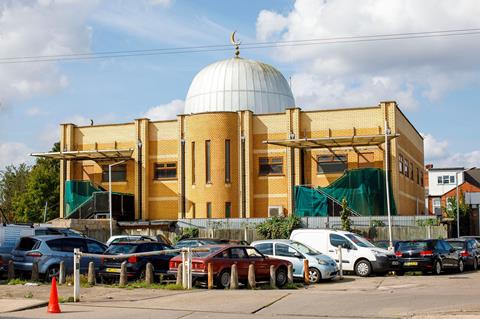
I recently visited the mosque called Masjid Faizul Islam in inner-city Birmingham, a couple of blocks away from Villa Park, with the artist Mahtab Hussain, whose mother lives nearby. It’s a purpose-designed building in two shades of atypical yellow brick, positioned at the end of a street of terraced houses. There we met Imam Yousef Zaman. He is a structural engineer by profession, as well as also being an imam, and he told me that he designed the building, which replaced a scrapyard.
He was proud of the way that the steel structure had been tensioned to allow the wide prayer hall to be column-free. The orientation of the prayer hall towards Mecca, and the absence of visual interruption of the view towards the mihrab (the niche in the wall that indicates the direction of Mecca), are the only two mandatory factors that define a mosque, according to Yousef. Otherwise, anywhere can be a mosque.
This is borne out by the exhibition of Mahtab Hussain’s work which is currently on at the Ikon Gallery in Birmingham until 1 June. It is a diverse exhibition called What Did You Want To See?, whose parts have in common the observation of Islam and Muslims. Within it is a section called Mosque City: Birmingham’s spiritual landscape. This is a photographic record of 160 mosques in the city.
The photographs are arranged, uncaptioned, in a large grid, and comparison is made in Ikon’s publicity with the work of Hilla and Bernd Becher. The Bechers meticulously recorded 19th and 20th century industrial structures such as blast furnaces, grain silos, electricity pylons and so on.
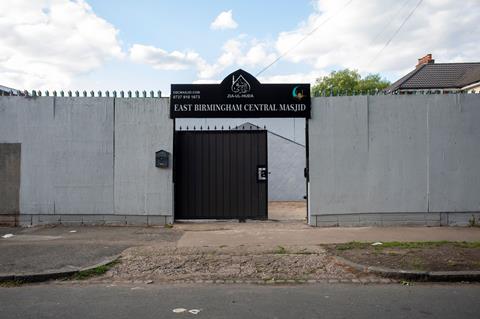
Their meticulousness was in the deadpan way in which the subjects were photographed: isolated from their surroundings, always in monochrome, always in sunless daylight, and exhibited in typological groups, like geological or zoological specimens.
The comparison does not in fact extend very far. Hussain’s photographs are in colour, some from close up, some from a distance, containing contextual detail of street furniture, parked cars and signage, and no attempt is made to group them into types. The main impression which the 160 photographs make is of the great diversity of the subjects.
I tried to make a content analysis of the buildings: which were purpose-designed, which were converted from houses, banks, churches, schools, factories, pubs or shops. But my analysis remained incomplete, because in many cases it is impossible to reliably identify the original purpose of the mosque from its present appearance, as it is so much altered.

Quite a number, at least 28 by my count, are purpose-designed new buildings. Few of them possess much architectural distinction, and not many, I would guess, were designed by architects.
Many adopt a faux-domestic architectural language, whether deliberately or by default, which could be interpreted, if you wished, as enabling them to blend inconspicuously into their largely residential contexts. By contrast, some of the larger buildings, notably the Central Mosque in Highgate and the Central Jamia Mosque in Small Heath, are elaborate and very conspicuous landmark buildings, complete with dome and minarets.
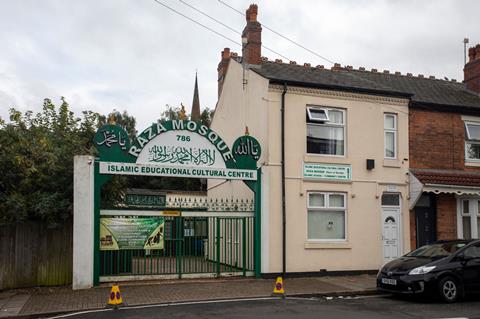
Of the conversions, the largest group is of houses. Most of these are low key, on the exterior at least. Several ex-banks feature, expressive of the closure of many bank branches. Among them are at least three ex-Birmingham Municipal Bank branch buildings, identifiable by their stuccoed ground-floor rustication.
Conversions of a variety of inner-city industrial buildings are included. Some of them are remarkably blank and utilitarian ex-industrial sheds, only identifiable as mosques by the sign attached to the building. Signs display varying attitudes to linguistic integration. Some are entirely in English – Bordesley Green Islamic Centre – some are in anglicised Arabic – Sultania Hadayat-al-Quran – and most are in a hybrid of the two.
Included is the purpose-built mosque in Birchfield which, notoriously, was initially prominently named the Saddam Hussein Mosque, paid for with £2 million from the Iraqi tyrant. It is now renamed as the Jame Masjid.
In some conversions, but certainly not all, there is evidence of a desire to make their appearance recognisably oriental and Islamic. Domes, minarets (most of them non-functional and purely symbolic), arched windows, arcades, polychromatic brickwork – none of these, according to Imam Yousef Zaman, are necessary for an Islamic liturgy. But clearly they have a potency and an inherent meaning which some find appropriate.
There is a parallel here with the Ecclesiological Movement in England in the 1840s and its promotion of the Gothic Revival as the only true Christian style. The addition of features with Islamic religious meaning to secular British buildings is sometimes slightly surreal.
A polychromatic brickwork minaret growing out of the end of a terrace of shops is amusing, but it also makes a notable local landmark in an otherwise rather bland streetscape. Interestingly, there is a remarkable correspondence in many cases between an Islamic architectural language and an early 20th-century Birmingham vernacular – lancet windows, round-arched windows, ceramic tiles, terracotta mouldings and string courses.
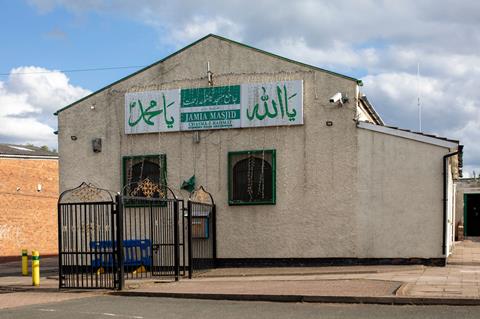
All in all, the converted buildings among the 160 Birmingham mosques are a striking confirmation of the accuracy of Jane Jacobs’ chapter in The Death and Life of Great American Cities which she called The Need for Aged Buildings. In it Jacobs argues that the existence of a pool of old buildings, whose initial capital costs have been amortised, and which are therefore relatively cheap to buy or rent, is one of four indispensable requisites for urban diversity, which she defines as the greatest characteristic of cities.
She writes: “Old ideas can sometimes use new buildings. New ideas must use old buildings.” It’s an economic argument for retrofit and reuse, unconnected with appearance, that this exhibition illustrates extremely well.
In What Did You Want To See? Mahtab Hussain’s objective photographic documentation of the 160 mosques is juxtaposed with his documentation of Project Champion. This was the name given to the installation of 218 CCTV cameras and ANPR (Automatic Number Plate Recognition) cameras, many of them installed covertly, in two Birmingham districts with high proportions of Muslim residents, Sparkbrook and Washwood Heath.
It began in 2008 and, after widespread community protests and the threat of judicial review, the cameras were dismantled in 2011. The rationale behind the project was to assist counter-terrorism, but it was widely perceived as illegitimate surveillance and even as racially prejudicial spying.
While documenting the project, Hussain makes no explicit comments about the installation, leaving visitors to come to their own conclusions. Implicit in his exhibition is a contrast between two kinds of street photography. One is overt, socially constructive and directed towards greater community understanding; the other is covert, based upon suspicion and reinforcing community division.
>> Also read: Marks Barfield completes Cambridge New Mosque
>> Also read: V&A’s Venice pavilion to celebrate the British mosque
Postscript
What Did You Want to See is at the Ikon Gallery in Birmingham until 1 June.
Joe Holyoak is an architect and urban designer based in Birmingham.


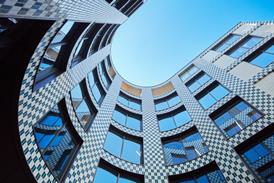
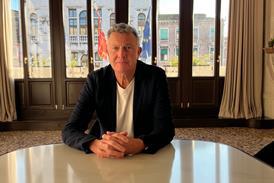
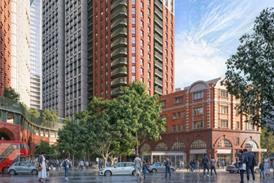
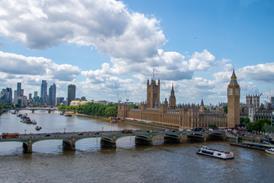










No comments yet